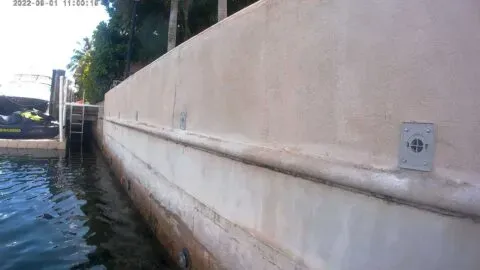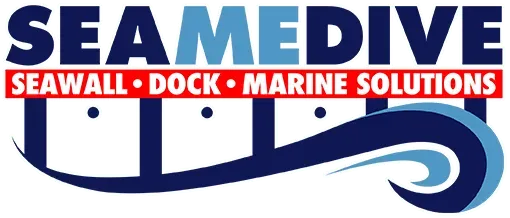Jet Filter System’s Maintainable Weep Hole Filters are a cost-effective solution to the issue of drainage and soil filtration in earth-retaining structures, including seawalls in the USA. Jet Filter systems are designed to be installed in both seawalls and retaining walls to prevent soil and backfill material from escaping.
According to David Heilman, CEO of JET Filter System, traditional drainage systems become clogged over time, causing pressure to build up behind the wall and causing damage. With this in mind, Jet Filters were designed to be easy to clean and maintain, resolving this issue. Sea Me Dive worked with Jet Filters directly during the development process of the product to make sure it would be the perfect solution to weep hole failure!
What Are Jet Filters?
Jet Filters are a drainage and erosion control unit installed flush into concrete seawalls or bulkheads. The Jet Filter relieves hydrostatic pressure behind the wall by providing a drainage path for water trapped behind the structure. This prevents soil and backfill material from being lost and helps to protect the seawall from damage. They do this by allowing water to drain from behind the wall while filtering out sediment and debris, preventing it from entering the water, thus protecting the integrity of the seawall and the property.

Why Are Jet Filters Important for Seawalls?
Prevents Erosion
One of the primary benefits of Jet Filters is their ability to prevent erosion, particularly in areas where soil filtration is essential for maintaining structural stability. Water flow management is crucial for preventing erosion and maintaining land integrity, especially in regions prone to heavy rainfall or rapid water runoff. Jet Filters operate by effectively regulating this flow, ensuring that excessive pressure on the soil is mitigated.
For instance, studies have shown that when implemented in agricultural settings, these filters can reduce surface runoff by up to 30%, significantly lowering the risk of soil displacement.
- In coastal areas, Jet Filters have been proven to reduce shoreline erosion rates by approximately 40%.
- In urban developments, they help manage stormwater, preventing soil saturation that leads to land collapses.
By utilizing this technology, Sea Me Dive customers have seen a significant decrease in the development of sinkholes and loss of sediment overall.
Reduces Maintenance Costs
By effectively managing hydrostatic pressure and ensuring optimal drainage, Jet Filters can significantly reduce maintenance costs associated with seawalls and other structures.
This innovative technology not only enhances the durability of various infrastructures but also minimizes the frequency and extent of repairs required over time. With reliable drainage systems, issues such as water accumulation, erosion, and structural deterioration can be proactively managed, leading to substantial cost savings.
- Lower repair expenses due to reduced wear and tear.
- Extended lifespan of critical structures such as seawalls.
- Improved efficiency in maintenance schedules and operations.
Investing in these solutions ultimately translates to fewer interruptions and enhanced structural integrity, benefiting both the environment and budget constraints.
How Do I Know If I Need Jet Filters for My Seawall?
Determining the need for Jet Filters for your seawall involves assessing hydrostatic pressure, drainage efficiency, and potential maintenance costs associated with water management.
Location of Seawall
The location of your seawall is a critical factor in determining the need for Jet Filters, as areas with high hydrostatic pressure and erosion risk will benefit significantly from their implementation.
When considering the geographical factors, one must account for the unique environmental conditions that shape the shoreline. Coastal areas prone to heavy rainfall or rapid tide fluctuations often experience increased water flow, which can lead to further erosion if not properly managed.
Here are some conditions to consider:
- Tidal Ranges: Regions with significant tidal ranges experience frequent water movement, increasing the necessity for robust filtration systems.
- Soil Composition: Types of soil beneath the seawall significantly impact hydrostatic pressure; sandy or loose soils are more susceptible to erosion.
- Wave Action: High-energy waves constantly battering the coast necessitate stronger defenses, making Jet Filters essential in these scenarios.
Understanding the interplay between geographical conditions and environmental challenges is essential for effectively utilizing Jet Filters to enhance seawall durability and protect coastal communities. Sea Me Dive can help you understand how best Jet Filters can help you and your property!
Water Conditions
Assessing water conditions, including flow patterns and hydrostatic pressure levels, is essential to determine the appropriate use of Jet Filters in seawall systems.
Understanding these factors is crucial since varying water levels can drastically impact not only the structural integrity of the seawall but also its overall effectiveness in protecting coastal properties. Sea Me Dive takes a look at all of these factors during our routine inspections, helping to determine how Jet Filters can best be used in your property. Implementing Jet Filters can mitigate some of these issues by allowing for better water regulation behind the seawall.
- Jet Filters can enhance water flow management.
- Different flow patterns can lead to increased pressure that may compromise seawall strength.
- Hydrostatic pressure levels can dictate the necessary precautions for maintaining a seawall’s durability.
By recognizing and adapting to dynamic water conditions,Sea Me Dive can help ensure that seawalls not only resist environmental stresses but also function optimally throughout their lifespan.
Budget and Maintenance Considerations
Budget and maintenance considerations play a significant role in deciding whether to implement Jet Filters for your seawall, as effective drainage can lead to long-term savings in maintenance costs.
When evaluating options, one must consider the initial investment alongside the projected operational expenses over time.
- Many individuals weigh the cost of installation against the potential for reduced wear and tear on the seawall structure.
- Anticipating future maintenance needs is crucial; Jet Filters can significantly lessen the frequency and severity of repairs.
Ultimately, integrating Jet Filters may yield a more sustainable solution, keeping budgetary and maintenance constraints in check.
What Are the Installation and Maintenance Processes for Jet Filters?
Installation Process
The installation process for Jet Filters involves careful planning, including the integration of maintainable weep holes to facilitate proper drainage and prevent water accumulation. Because of this, it is always recommended to have a knowledgable marine contractor, such as Sea Me Dive, install the fitlers for optimal results.
To ensure success, the following steps must be taken:
- Assess Site Conditions: Before beginning, the site where the Jet Filters will be installed must be thoroughly evaluated. A seawall inspection with Sea Me Dive will give all the information needed to assess whether or not the wall needs filters, how many, and where they need to be installed.
- Excavate Properly: The installation area will be cleaned and then core-drilled to make a hole for the filter to be installed.
- Install Weep Holes: The weep holes are placed into the hole and installed so they are flush against the wall. This allows for optimal drainage.
Following these guidelines will lead to an effective and efficient installation of Jet Filters, guaranteeing best performance and longevity.
Maintenance Process
Regular maintenance of Jet Filters is essential to ensure performance and mitigate challenges related to hydrostatic pressure in drainage systems, particularly in urban settings where infrastructural demands can significantly impact functionality. By adhering to a structured maintenance schedule, one can prevent clogs and ensure the smooth operation of the filtration system, thereby enhancing its longevity and efficiency. Routine checks not only preserve the equipment’s integrity but also result in lower maintenance costs over time.
To effectively maintain Jet Filters, it’s crucial to implement the following procedures:
- Visual Inspections: Conduct regular visual inspections to identify any signs of wear and tear, leaks, or accumulation of debris. Sea Me Dive always checks the status of Jet Filters and other weep holes during routine inspections.
- Cleaning: Schedule frequent cleaning of the filter elements to remove any buildup that could impair performance. Sea Me Dive recommends you get your filters cleaned and maintenanced every two years.
- Replace Parts: Promptly replace any faulty components to avoid further operational issues.
By following these maintenance steps, one can significantly enhance the lifecycle of Jet Filters, ensuring they continue to operate efficiently and effectively.
Can I install Jet Filters myself?
It is recommended to hire a professional company experienced in seawall repair and construction to properly install Jet Filters. This will ensure they are installed correctly and effectively protect your seawall. Sea Me Dive has been working closely with Jet Filters for years andh as significant experience in installing, maintaining, and fixing jet filters. Call Sea Me Dive today to schedule your seawall inspection and jet filter installation/maintenance today! 754-265-7115
